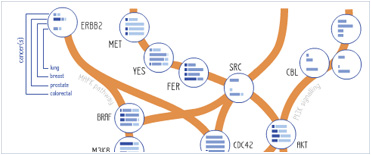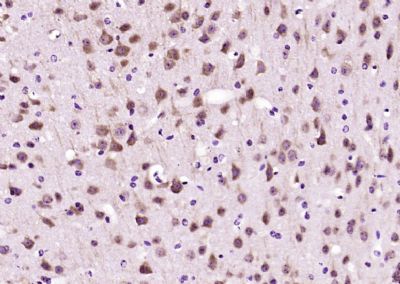ARF5 Polyclonal Antibody
Purified Rabbit Polyclonal Antibody (Pab)
- SPECIFICATION
- CITATIONS
- PROTOCOLS
- BACKGROUND

Application
| WB, IHC-P, IHC-F, IF, ICC, E |
|---|---|
| Primary Accession | P84085 |
| Reactivity | Rat, Bovine |
| Host | Rabbit |
| Clonality | Polyclonal |
| Calculated MW | 20 KDa |
| Physical State | Liquid |
| Immunogen | KLH conjugated synthetic peptide derived from human ARF5 |
| Epitope Specificity | 15-120/180 |
| Isotype | IgG |
| Purity | affinity purified by Protein A |
| Buffer | 0.01M TBS (pH7.4) with 1% BSA, 0.02% Proclin300 and 50% Glycerol. |
| SUBCELLULAR LOCATION | Golgi apparatus. Cytoplasm > perinuclear region. |
| SIMILARITY | Belongs to the small GTPase superfamily. Arf family. |
| SUBUNIT | Binds ASAP2. Interacts with NCS1/FREQ at the Golgi complex. Interacts with RAB11FIP3 and RAB11FIP4. |
| Important Note | This product as supplied is intended for research use only, not for use in human, therapeutic or diagnostic applications. |
| Background Descriptions | The ADP-ribosylation factor (ARF) protein family are structurally and functionally conserved members of the Ras superfamily of regulatory GTP-binding proteins. ARFs influence vesicle trafficking and signal transduction in eukaryotic cells. ARF-dependent regulatory mechanisms include the coordination of spectrin interactions with golgi membranes and the association of actin to the golgi via rho family-dependent G-protein localization (Rac, CDC42) and WASP/Arp2/3 complexes. Additionally, ARFs play a central role in maintenance of organelle integrity, assembly of coat proteins, and activation of phospho-lipase D. The ARF proteins are categorized as class I (ARF1, ARF2, and ARF3), class II (ARF4 and ARF5) and class III (ARF6); members of each class share a common gene organization. |
| Gene ID | 381 |
|---|---|
| Other Names | ADP-ribosylation factor 5, ARF5 |
| Dilution | WB=1:500-2000,IHC-P=1:100-500,IHC-F=1:100-500,ICC=1:100-500,IF=1:100-500,ELISA=1:5000-10000 |
| Format | 0.01M TBS(pH7.4), 0.09% (W/V) sodium azide and 50% Glyce |
| Storage | Store at -20 ℃ for one year. Avoid repeated freeze/thaw cycles. When reconstituted in sterile pH 7.4 0.01M PBS or diluent of antibody the antibody is stable for at least two weeks at 2-4 ℃. |
| Name | ARF5 |
|---|---|
| Function | GTP-binding protein involved in protein trafficking; may modulate vesicle budding and uncoating within the Golgi apparatus. |
| Cellular Location | Golgi apparatus. Cytoplasm, perinuclear region. Membrane; Lipid-anchor. Golgi apparatus, trans-Golgi network membrane {ECO:0000250|UniProtKB:P84084}; Lipid-anchor {ECO:0000250|UniProtKB:P84084} |

Thousands of laboratories across the world have published research that depended on the performance of antibodies from Abcepta to advance their research. Check out links to articles that cite our products in major peer-reviewed journals, organized by research category.
info@abcepta.com, and receive a free "I Love Antibodies" mug.
Provided below are standard protocols that you may find useful for product applications.
If you have used an Abcepta product and would like to share how it has performed, please click on the "Submit Review" button and provide the requested information. Our staff will examine and post your review and contact you if needed.
If you have any additional inquiries please email technical services at tech@abcepta.com.













 Foundational characteristics of cancer include proliferation, angiogenesis, migration, evasion of apoptosis, and cellular immortality. Find key markers for these cellular processes and antibodies to detect them.
Foundational characteristics of cancer include proliferation, angiogenesis, migration, evasion of apoptosis, and cellular immortality. Find key markers for these cellular processes and antibodies to detect them. The SUMOplot™ Analysis Program predicts and scores sumoylation sites in your protein. SUMOylation is a post-translational modification involved in various cellular processes, such as nuclear-cytosolic transport, transcriptional regulation, apoptosis, protein stability, response to stress, and progression through the cell cycle.
The SUMOplot™ Analysis Program predicts and scores sumoylation sites in your protein. SUMOylation is a post-translational modification involved in various cellular processes, such as nuclear-cytosolic transport, transcriptional regulation, apoptosis, protein stability, response to stress, and progression through the cell cycle. The Autophagy Receptor Motif Plotter predicts and scores autophagy receptor binding sites in your protein. Identifying proteins connected to this pathway is critical to understanding the role of autophagy in physiological as well as pathological processes such as development, differentiation, neurodegenerative diseases, stress, infection, and cancer.
The Autophagy Receptor Motif Plotter predicts and scores autophagy receptor binding sites in your protein. Identifying proteins connected to this pathway is critical to understanding the role of autophagy in physiological as well as pathological processes such as development, differentiation, neurodegenerative diseases, stress, infection, and cancer.


